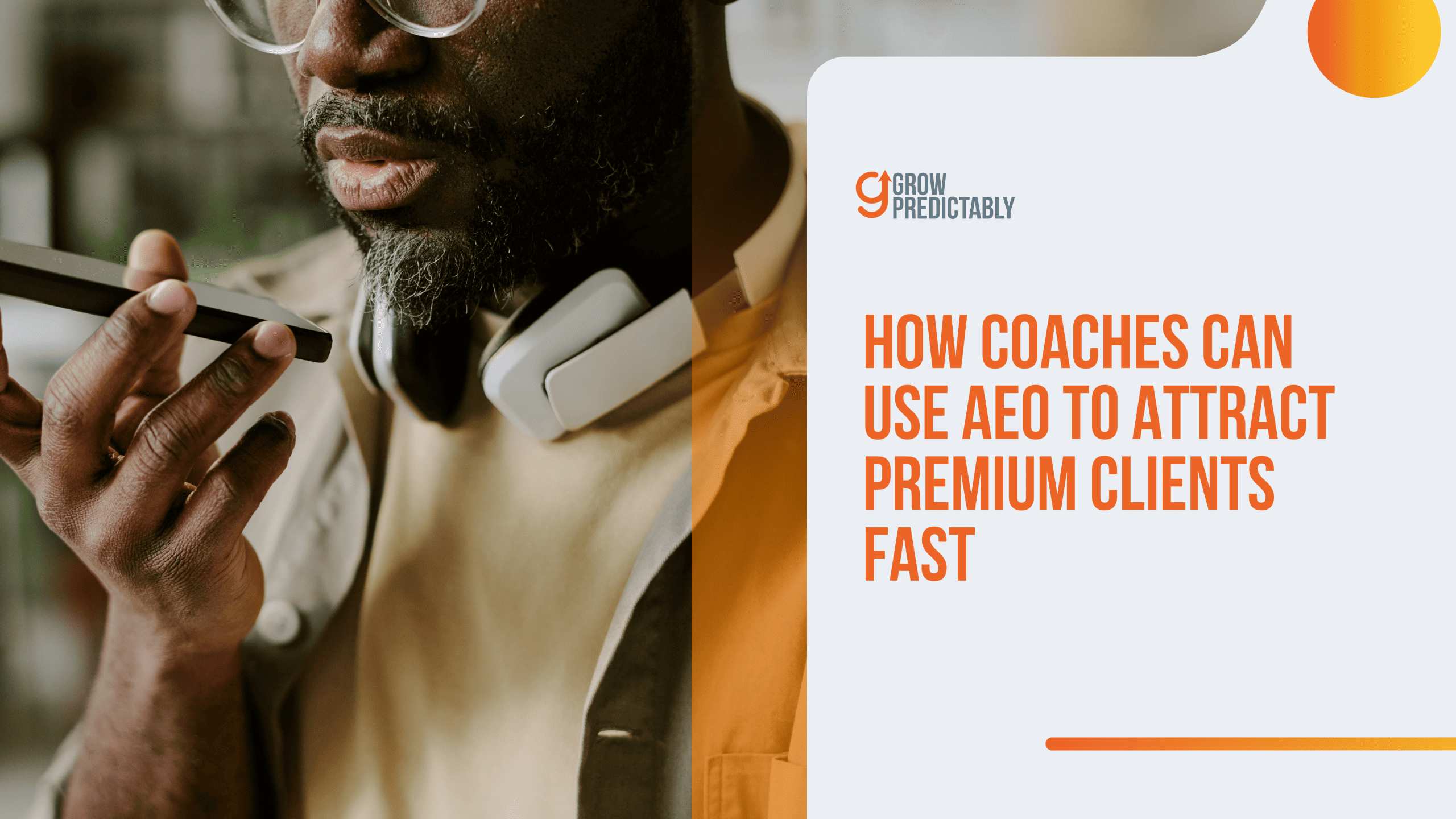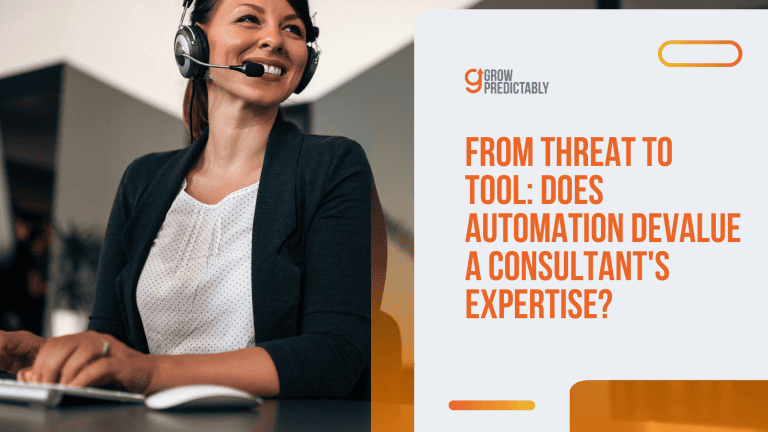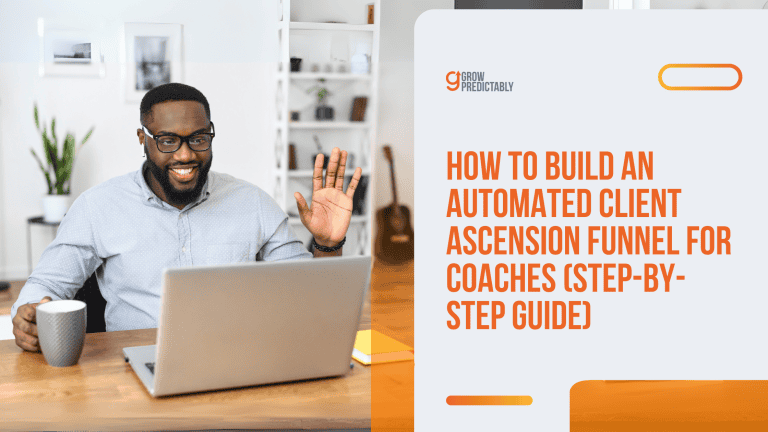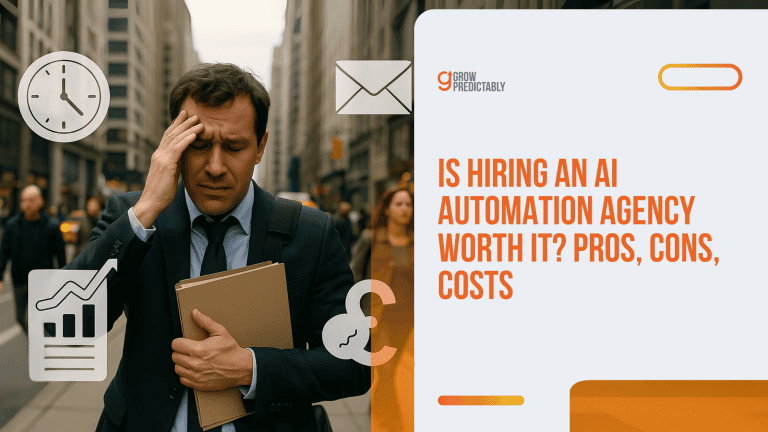How Coaches Can Use AEO to Attract Premium Clients Fast
Premium coaches face a visibility crisis: 25% of organic traffic is shifting to AI chatbots and virtual agents by 2026, yet most coaching expertise remains invisible to these AI-powered discovery systems.
High-value clients no longer scroll through Google results—they ask ChatGPT, Claude, or Perplexity direct questions about strategic challenges and trust whatever answer appears first.
When a Fortune 500 executive asks “How should I navigate board communication during a major pivot,” AI either surfaces your framework or someone else’s—there’s no second place in this new search landscape.
Answer Engine Optimization (AEO) positions coaches as the authoritative source AI systems cite directly—by structuring content around sophisticated executive queries, implementing schema markup that AI can parse, and building thought leadership that establishes genuine expertise.
Let’s break down how AEO shifts this dynamic.
TL;DR
AEO is a strategy that helps position different sources directly in AI-generated answers, helping you become an authoritative source for your coaching clients who seek immediate, strategic insights. Unlike SEO, AEO focuses on structuring content to deliver immediate value to specific queries on AI search engines.
KEY TAKEAWAYS
- Tailor your content to match the sophisticated queries of premium clients by focusing on direct answers to complex executive problems.
- Implement advanced schema markup and optimize for voice search to enhance visibility in AI-driven platforms, ensuring your expertise is recognized and surfaced efficiently.
- Establish thought leadership through comprehensive content clusters and strategic professional networks, which amplifies your expertise and visibility in executive circles.
Table of Contents
What Is AEO and How Does It Transform High-Ticket Coaching Discovery?
Answer Engine Optimization (AEO) is a digital marketing strategy that involves optimizing your web content to appear in AI-generated responses to user queries.
Instead of hoping prospects will click through to your website from search results, AEO focuses on getting your expertise directly featured in the answers that AI systems provide to strategic questions.
When a Fortune 500 CEO asks ChatGPT or Claude about navigating a complex organizational restructuring, your methodology could be the framework that gets referenced in the response.
This direct integration into AI-generated answers positions you as the authoritative source without requiring prospects to evaluate multiple competing options.
Marketing is the distinguishing, unique function of the business.”
peter drucker, Management theory pioneer
Search behavior is shifting, with 25% of organic traffic predicted to move to AI chatbots and virtual agents by 2026.
Premium clients are leading this transition because they value efficiency and direct answers over lengthy research processes.
They want strategic insights immediately, not after reviewing multiple consultant websites.
The fundamental difference is this: traditional search engine optimization (SEO) aims to get you found on search engines like Google, while AEO aims to get your expertise directly delivered as the authoritative answer.
Optimizing for search engines such as Google requires a different approach than AEO, as AEO is designed for AI-driven platforms rather than just traditional search engine rankings.
Understanding user intent is crucial for AEO, since AI systems and search engines prioritize content that aligns with the underlying motivations behind queries.
For high-ticket coaching, this means your frameworks and methodologies become the default solutions that AI systems recommend for executive-level challenges.
This requires structuring your content around the actual questions premium clients ask, not the keywords they might type.
- Content structure: AEO demands direct answers in the first few sentences, while SEO allows for longer introductory sections
- Query targeting: AEO focuses on specific, conversational questions and targets long tail, conversational queries to better match the specific questions premium clients are asking, rather than broad keyword themes
- Success metrics: AEO measures inclusion in AI responses rather than click-through rates from search results
- Optimization approach: AEO emphasizes short, structured formats like FAQs, featured snippets, and schema markup, while SEO favors long-form, keyword-rich content
For coaching practices, this shift means your content needs to answer sophisticated strategic questions with the depth and nuance that executive prospects expect.
Generic leadership advice won’t get featured in AI responses—only specific, actionable frameworks for complex executive challenges will make the cut.
How Can You Position Yourself as a Premium Coach Through Strategic AEO?
You can’t be seen until you learn to see.”
seth godin, Marketing thought leader
Premium coaching clients don’t search like everyone else.
Understanding your target audience and their specific needs is essential to connect with those seeking premium coaching services.
They ask nuanced questions that reveal their sophistication and buying power.
Your AEO strategy needs to implement the right strategies to attract your ideal client and match their mindset, not chase mass market keywords that attract tire-kickers.
Ensure your messaging speaks directly to the unique challenges and goals of your target audience.
Target High-Intent Conversational Queries
Stop wasting time on broad keywords that attract everyone and convert no one.
Premium clients ask specific questions that reveal they’re already thinking at an executive level.
Understanding what these clients are searching for allows you to tailor your content to their needs and ensure you show up when they are actively looking for solutions.
When someone searches “How do I transition from corporate executive to entrepreneur,” they’re not window shopping—they’re evaluating coaches who understand their exact situation.
Your content should mirror the sophisticated language and concerns of high-level professionals.
These aren’t people asking “how to make money online”—they’re asking about board governance, succession planning, or scaling teams across multiple markets.
- Executive transition queries: “How do I maintain my network while starting a competing business?”
- Strategic leadership questions: “What’s the best way to restructure my executive team during rapid growth?”
- High-stakes decision making: “Should I accept private equity investment or bootstrap to $10M ARR?”
- Industry-specific challenges: “How do pharmaceutical executives transition to biotech startups?”
Research tools like AnswerThePublic and Google’s “People Also Ask” will surface these premium queries, but you need to think beyond the tools.
Join executive forums, LinkedIn groups, and industry associations where your ideal clients actually spend time.
According to McKinsey’s research, 70% of senior executives seek external coaching specifically during major business transitions.
Establish Authority Through Direct Answer Format
Your prospects are smart enough to spot marketing tactics from miles away.
They want substance immediately, not three paragraphs of setup before you get to the point.
Start with your best insight in the first sentence, then build your case.
The most effective premium positioning happens when you demonstrate expertise without asking for anything in return.
Answer their question completely and thoroughly—this builds the trust that converts high-value clients and demonstrates your credibility.
- Lead with your strongest point: State your main recommendation in sentence one
- Back it with specific methodology: Explain your framework or process step-by-step
- Include real consequences: Show what happens when executives get this wrong
- End with actionable next steps: Give them something they can implement immediately
Premium clients can afford to pay for shortcuts and proven systems.
They’re not looking for generic advice they could find anywhere—they want strategies that account for their unique constraints and opportunities.
When you consistently deliver this level of insight through your AEO content, showcasing exceptional results, you naturally filter for clients who value expertise over price.
By consistently providing valuable, direct answers, you are building authority in your niche and enhancing your long-term credibility.
What Types of Authority-Building Content Attract Premium Clients Through AEO?
Premium clients don’t consume content the same way mass market prospects do.
They’re looking for depth, proven methodologies, and insights they can’t get elsewhere.
Your content strategy needs to match their sophistication level and decision-making process.
A strong content strategy not only builds trust but also helps generate more leads from premium clients.
On average, helpful information is read by 75% more people than copy which deals only with the product.”
DAVID OGILVY, Advertising legend innovator
Develop Comprehensive Q&A Content
Most coaches create surface-level content that scratches the itch but never solves the problem.
Premium clients need comprehensive frameworks they can actually implement.
When a C-suite executive asks about organizational restructuring, they don’t want a 500-word blog post—they want a complete methodology with contingencies and risk mitigation strategies.
Your Q&A content should read like the strategic briefings these executives receive from McKinsey or Deloitte.
Deep, thorough, and immediately actionable.
This isn’t about writing longer content for the sake of it—it’s about providing complete solutions to complex problems.
Showcasing your skills in developing these solutions demonstrates your ability to address the specific needs of potential clients, making your content more relevant and valuable to them.
- Multi-layered problem solving: Address the surface question plus the underlying strategic implications
- Detailed implementation roadmaps: Break down complex processes into executable phases with timelines
- Risk assessment frameworks: Include what could go wrong and how to prevent it
- Decision matrices: Help executives evaluate options using their own criteria
Structure your content to mirror how premium clients actually think and speak.
Use headings like “How should I approach board communication during a major pivot?” instead of “Board Communication Tips.”
Research by Harvard Business Review shows that senior executives prefer content that addresses specific situational challenges over generic best practices.
Your frameworks need to account for the constraints these leaders actually face—regulatory requirements, stakeholder management, public company considerations.
When you demonstrate this level of understanding through your content, you automatically filter for clients who operate at this level.
Leverage Case Studies in Question-Answer Format
Generic case studies are boring. Question-formatted case studies are magnetic.
Instead of “Client Success Story #47,” try “How did a biotech CEO navigate FDA approval while scaling from $10M to $100M revenue?”
The question format makes it discoverable through AEO while the specific details attract the right prospects.
Premium clients want to see proof that you’ve solved problems similar to theirs, at their scale, with their constraints.
Demonstrating your ability to convert prospects into paying clients and deliver exceptional results builds trust and credibility.
They’re not impressed by helping someone go from zero to six figures—they need to see evidence you can operate in their world.
- Industry-specific transformations: Document results within their exact sector and regulatory environment
- Quantifiable leadership metrics: Show measurable improvements in team performance, decision speed, or strategic execution
- Stakeholder management wins: Demonstrate how you helped navigate complex relationships with boards, investors, or regulatory bodies
- Crisis leadership examples: Showcase how your coaching performed under genuine pressure situations
Each case study should read like a strategic post-mortem that other executives would actually want to study.
Include the decision-making process, the implementation challenges, and the metrics that mattered most to the client’s board or investors.
When you consistently demonstrate this level of sophistication, premium clients recognize you understand their world.
Create Original Research and Industry Insights
Anyone can regurgitate existing research.
Premium coaches create new knowledge.
When you publish original research on topics that matter to high-level executives, you’re not just creating content—you’re establishing yourself as the definitive source on that topic.
AI engines prioritize original, authoritative content because it provides unique value that users can’t find elsewhere.
Your research doesn’t need to be academic-level, but it needs to reveal insights that change how executives think about key decisions.
- Executive decision-making studies: Survey C-suite leaders about their biggest challenges and blind spots
- Industry transformation analysis: Track how successful leaders navigate major industry shifts
- Performance correlation research: Identify what actually drives results at the executive level
- Leadership effectiveness metrics: Create new frameworks for measuring strategic leadership impact
The frameworks you have created can help businesses, including small businesses, refine their business model to better serve their clients and adapt to changing market demands.
Focus your research on questions that keep your ideal clients awake at night.
According to PwC’s Annual Global CEO Survey, 73% of CEOs believe their organization won’t be economically viable in ten years if they continue on their current path.
Research that helps them navigate this uncertainty positions you as essential, not optional.
Your insights should influence how other industry experts think about these topics.
When your research gets cited by major publications or referenced in other executive content, you’ve achieved true thought leadership positioning that premium clients recognize and value.
Which Technical AEO Elements Signal Professional Credibility?
Premium clients notice details that mass market prospects ignore.
When a Fortune 500 executive lands on your site, they’re unconsciously evaluating whether you operate at their level of professionalism.
Technical excellence isn’t just about search rankings—it’s about credibility and first impressions that determine whether they see you as an equal or another amateur coach.
Managing your site’s links and link structure, including fixing broken links and optimizing both internal and external links, is a crucial part of technical SEO that enhances your website’s authority and crawlability.
Implement Advanced Schema Markup
Most coaches think schema markup is too technical to matter.
They’re wrong.
When AI systems can easily parse and understand your content structure, they’re more likely to surface it for sophisticated queries.
But beyond search benefits, proper schema markup signals that you understand professional web standards—something premium clients expect from serious business partners.
Schema markup helps AI engines extract exactly the information they need to answer complex questions.
When someone asks their AI assistant about executive coaching methodologies, properly marked-up content gets pulled into responses while unmarked content gets ignored.
- FAQ Schema for Q&A content: Structures your expertise in formats AI systems readily understand and extract
- Person Schema for your bio: Establishes credibility with credentials, affiliations, and recognition markers
- Organization Schema: Legitimizes your coaching practice with proper business entity information
- Service Schema for offerings: Clearly defines what you provide and at what level of expertise
- Article Schema for thought leadership: Helps AI systems understand the context and authority of your insights
The technical implementation sends a subtle but powerful message about your attention to detail and professional standards.
When premium clients see that you’ve invested in proper technical infrastructure, it reinforces that you operate at their level of business sophistication.
Google’s own research shows that structured data helps search systems better understand and represent content, leading to improved visibility for complex queries.
Optimize for Voice Search and AI Platforms
Executive-level professionals increasingly rely on voice assistants for quick strategic insights during commutes, between meetings, or while reviewing reports.
They’re not typing “coaching tips”—they’re asking specific questions like “What’s the most effective way to communicate a major strategic shift to stakeholders?”
Your content needs to match how they naturally speak and think.
Voice optimization isn’t about stuffing keywords into conversational phrases.
It’s about understanding how sophisticated professionals actually formulate questions when they need strategic guidance.
These queries tend to be longer, more specific, and context-heavy compared to traditional search behavior.
- Natural conversation patterns: Write content that matches how executives actually discuss strategic challenges
- Question-based section headers: Mirror the exact phrasing premium clients use when seeking guidance
- Complete answer structures: Provide thorough responses that voice assistants can extract and deliver effectively
- Context-rich explanations: Include the background information that makes your answers actionable at the executive level
Premium clients often multitask while consuming content, making voice-friendly formats essential for capturing their attention.
When your content performs well in voice search results, it positions you as the go-to expert for executive-level strategic guidance—exactly where premium clients expect to find authoritative answers.
Create Mobile-First, Fast-Loading Experiences
Slow websites are business killers when dealing with premium clients.
These are people who value their time more than almost anything else.
A site that takes more than two seconds to load signals that you don’t understand urgency or professional standards.
Beyond user experience, technical performance directly impacts how AI systems crawl and index your content.
Premium executives consume content differently than typical prospects.
They scan quickly, jump between devices, and expect seamless experiences that match their other professional tools.
Your website needs to perform like the enterprise software they use daily, not like a hobbyist blog.
- Sub-2-second load times: Meet the performance standards that premium clients expect from professional services
- Mobile-responsive design: Ensure flawless functionality across all devices executives use throughout their day
- Clean, professional aesthetics: Visual design that reinforces your positioning as a serious business partner
- Intuitive navigation structure: Information architecture that matches how executives process and prioritize information
- Accessible contact options: Clear pathways for high-value prospects to engage without friction
Technical excellence creates a halo effect that influences how prospects perceive your coaching capabilities.
When everything works perfectly, premium clients assume you bring the same level of precision to your coaching methodology.
Google’s Core Web Vitals research demonstrates that page experience factors directly influence search rankings, making technical optimization essential for visibility among sophisticated queries.
Your technical infrastructure should be invisible to users but obvious to AI systems that evaluate content quality and authority.
This behind-the-scenes excellence signals the kind of professional competence that premium clients expect from their strategic advisors.
How Do You Build Industry Authority Through Strategic AEO Implementation?
Authority isn’t built overnight, and premium clients can spot manufactured credibility instantly.
Real industry authority comes from consistently demonstrating expertise across multiple channels while building the professional relationships that matter in executive circles.
Your AEO strategy needs to reflect genuine expertise, not just clever content optimization.
Establish Expertise Through Consistent Expert Positioning
Premium clients research potential coaches the same way they evaluate strategic partners—they look for patterns of credibility across multiple sources.
One impressive article won’t convince them.
They need to see consistent evidence that you operate at their level and understand their challenges from real experience, not theoretical knowledge.
Your expertise positioning needs to pass the executive assistant test.
When a CEO’s assistant researches potential coaches, they’re looking for credentials and recognition that justify the investment.
They want to see that other sophisticated professionals have already validated your expertise.
- Industry publication bylines: Regular contributions to publications that premium clients actually read, like Harvard Business Review or McKinsey Insights
- Speaking engagements at major conferences: Keynotes and panel discussions at events where your ideal clients gather to learn from peers
- Podcast appearances on respected shows: Strategic media appearances that demonstrate your expertise to target audiences
- Professional certifications and credentials: Industry-recognized qualifications that validate your methodology and approach. Many coaches, including life coaches, leadership coaching specialists, and energy healers, can benefit from establishing recognized expertise in their respective fields.
- Peer recognition and awards: Acknowledgment from other professionals who serve similar clientele
The key is consistency across touchpoints.
Each piece of evidence should reinforce the same core message about your expertise and approach.
According to Edelman’s Trust Barometer, 81% of decision-makers need to trust a brand to buy from them, and trust builds through repeated exposure to credible expertise demonstrations.
Your expert positioning should make it obvious why premium clients should choose you over internal development or larger consulting firms.
When someone googles your name, the results should immediately communicate that you’re the definitive expert on specific executive challenges.
Develop Thought Leadership Content Clusters
Random content creation doesn’t build authority—systematic content clusters do.
Premium clients need to see that you’ve developed comprehensive frameworks around their most pressing challenges.
When they find one piece of your content helpful, they should discover an entire ecosystem of related insights that demonstrates the depth of your expertise.
Content clusters signal to AI systems that you’re the authoritative source on specific topics.
Instead of competing for individual keywords, you own entire problem categories that matter to premium clients.
This approach also matches how executives actually consume content—they want complete solutions, not scattered tips.
- Core methodology frameworks: Comprehensive guides that break down your signature approaches into implementable systems
- Supporting tactical content: Detailed articles that address specific aspects of your main frameworks
- Case study collections: Multiple examples of your methodology applied across different industries and situations
- Implementation resources: Tools, templates, and checklists that help executives apply your insights immediately. Consider offering a free guide as part of your content cluster—created specifically to help executives implement your frameworks step by step.
- Advanced strategy pieces: Higher-level content that connects your approach to broader business strategy and market dynamics
Each cluster should demonstrate progressively deeper expertise while staying focused on problems that premium clients actually face.
When someone discovers your executive transition content, they should find everything from initial assessment tools to advanced stakeholder management strategies.
This comprehensive approach positions you as the complete solution rather than just another content creator.
Build Strategic Professional Networks
Premium coaching doesn’t happen in isolation—it’s part of a broader ecosystem of professional services that sophisticated clients use.
Your AEO visibility increases dramatically when you’re connected to the other professionals who serve your target market.
Strategic relationships amplify your content reach while adding credibility through association.
Building networks with other businesses, including small businesses, can expand your reach and credibility by exposing your coaching business to new audiences and potential client groups.
The right professional network does more than provide referrals—it validates your positioning in the market.
When management consultants, executive recruiters, and business attorneys recognize you as a peer, premium clients notice.
These relationships also create content collaboration opportunities that expand your reach within executive circles.
- Management consulting firms: Partners who handle strategy while you focus on leadership development and executive effectiveness
- Executive search consultants: Recruiters who place C-suite talent and understand the transition challenges your coaching addresses
- Corporate attorneys and advisors: Legal professionals who work on M&A, succession planning, and other major executive decisions
- Investment banking and private equity contacts: Financial professionals who understand the performance pressures your clients face
- Board directors and governance experts: Leaders who can validate your approach to executive development and strategic leadership
These relationships should feel natural, not forced.
Focus on professionals who genuinely serve complementary needs for the same client base.
When they reference your expertise in their own content or recommend your insights to their clients, it creates powerful third-party validation that premium prospects trust more than self-promotion.
Strategic networking also creates opportunities for collaborative content that reaches larger, more targeted audiences.
Co-authored research, joint webinars, and cross-referenced case studies all signal that you operate within the professional ecosystem that premium clients expect from serious strategic advisors.
What Content Marketing Strategies Specifically Attract Premium Clients Through AEO?
Premium clients don’t respond to the same content marketing tactics that work for mass market prospects.
They’re evaluating you as a potential strategic partner, not just another service provider.
Your content strategy needs to demonstrate the same level of sophistication and strategic thinking they expect from their other professional advisors.
This notion of being where your audience are isn’t new… the growth of AI overviews (and therefore zero click results) is a big shift for SEO.”
RANK FISHKIN, SEO industry expert
Create Premium-Focused Lead Magnets
Generic lead magnets like “5 Tips for Better Leadership” won’t impress executives who already know the basics.
Premium clients need resources that address their specific constraints—public company governance requirements, stakeholder management complexity, or regulatory compliance issues.
Your lead magnets should feel like the strategic briefings they receive from McKinsey or BCG.
The resources you have created should help build trust with potential clients by demonstrating your expertise and understanding of their unique challenges.
The key is providing frameworks they can immediately apply to real situations.
When a Fortune 500 CEO downloads your executive transition assessment, it should feel like a tool they could use in an actual board presentation.
This level of sophistication naturally filters for prospects who operate at the executive level.
- Strategic assessment tools: Comprehensive frameworks that help executives evaluate complex situations with multiple stakeholders
- Industry-specific white papers: Deep research on challenges facing leaders in particular sectors or regulatory environments
- Decision-making matrices: Structured approaches for high-stakes choices with significant organizational impact
- Crisis leadership playbooks: Step-by-step guides for navigating public relations disasters, regulatory investigations, or market disruptions
- Board communication templates: Professional formats for presenting strategic initiatives, performance updates, or transformation plans
Structure these resources in question-and-answer format to maximize AEO optimization while maintaining professional credibility.
Instead of “Executive Leadership Assessment,” title it “How Should C-Suite Leaders Evaluate Their Strategic Leadership Effectiveness?”
This approach captures voice search queries while providing the comprehensive value premium clients expect.
Each lead magnet should position your full coaching engagement as the logical next step for implementation.
When someone completes your strategic assessment, the natural question becomes “How do I address these gaps?”
Your coaching program should be the obvious answer to that strategic need.
Utilize Video Content for Trust and Authority
Premium clients invest significant money in coaching relationships, making trust absolutely essential.
Video content allows prospects to evaluate your communication style, strategic thinking, and executive presence before they engage.
This preview capability is crucial for busy executives who can’t afford to waste time on discovery calls with coaches who don’t match their sophistication level.
Your videos need to demonstrate the same caliber of insights these executives receive from their other professional advisors. Think strategy briefings, not motivational pep talks.
Showcasing your skills in these videos is essential for building credibility with premium clients, as it highlights your expertise and ability to deliver real value.
Address complex scenarios with nuanced solutions that account for real-world constraints and stakeholder considerations.
- Strategic situation analysis: Break down current business challenges that affect multiple industries or executive roles
- Framework demonstrations: Walk through your methodologies using realistic scenarios that premium clients face
- Industry trend commentary: Provide sophisticated analysis on market shifts, regulatory changes, or competitive dynamics
- Case study presentations: Detail how you’ve helped other executives navigate similar challenges without compromising confidentiality
- Q&A sessions addressing premium concerns: Answer the specific questions that keep C-suite leaders awake at night
Optimize your videos for both traditional search and AI video analysis systems.
Use clear, descriptive titles that match how executives search for strategic guidance.
Include detailed descriptions and transcripts that help AI systems understand and extract your insights for voice queries.
The goal isn’t viral content—it’s building trust with the right audience.
According to Wyzowl’s Video Marketing Statistics, 89% of people say watching a video has convinced them to buy a product or service, but for premium clients, the decision factors are credibility and strategic value, not entertainment value.
Implement Strategic Email Nurture Sequences
Mass market email sequences focus on overcoming objections and building urgency.
Premium client sequences focus on continuous value delivery and strategic relationship building.
These emails are designed for building relationships over time, helping to develop trust and genuine connections through consistent engagement.
These prospects aren’t comparing prices—they’re evaluating whether you understand their world well enough to provide meaningful strategic guidance.
Your email sequence should feel like receiving strategic updates from a trusted advisor who understands the executive landscape.
Each message should provide insights they could immediately apply or share with their own teams, reinforcing your value as a strategic thinking partner.
- Weekly strategic briefings: Industry analysis and leadership insights relevant to current market conditions
- Framework deep-dives: Detailed explanations of methodologies with real-world application examples
- Peer insight sharing: Anonymous case studies and lessons learned from other executive engagements
- Market intelligence updates: Early warnings about trends or challenges that could affect their strategic planning
- Executive decision support: Tools and frameworks for upcoming strategic decisions or organizational challenges
Structure your sequence around progressive strategic questions that build toward natural coaching conversations.
Start with broad industry challenges, then narrow to specific leadership scenarios, and finally focus on personalized strategic development opportunities.
The nurture sequence should reinforce your positioning as someone who operates at their level of strategic sophistication.
When they forward your insights to their own teams or reference your frameworks in strategy discussions, you’ve achieved the kind of professional integration that leads to premium coaching engagements.
Each email should demonstrate that you understand the complexity of their role while providing actionable value.
This approach builds trust through consistent delivery of strategic insights rather than traditional sales pressure tactics.
In addition to content marketing, integrating ads—such as Google Ads—and leveraging social media can help you reach a larger audience and attract premium clients as part of a comprehensive strategy.
Leveraging social media platforms and creating engaging social media content are essential for distributing your authority-building content, which increases your online visibility and brand visibility.
What Advanced Strategies Ensure Sustained Premium Growth Through AEO?
Sustainable premium growth requires systematic approaches that compound over time.
Refining your business model is essential for long-term success, ensuring your coaching business can adapt and thrive as the market evolves.
One-off tactics won’t build the consistent pipeline of high-value clients you need.
Your AEO strategy must create multiple pathways for discovery while reinforcing your expertise across every touchpoint where premium prospects evaluate potential partners.
Implement Cross-Platform Content Distribution
Premium clients don’t exist in a single digital ecosystem.
They consume content across multiple platforms depending on context—LinkedIn during commutes, industry publications for deep research, podcasts during workouts, and conference platforms for strategic learning.
Your content distribution strategy needs to match their consumption patterns while optimizing for each platform’s specific AI algorithms.
Different AI systems pull from different data sources, meaning your visibility depends on strategic presence across multiple platforms.
Google’s algorithm prioritizes different signals than LinkedIn’s content engine, which operates differently from podcast discovery systems.
Each platform requires tailored optimization while maintaining consistent messaging about your expertise.
- LinkedIn for professional networking: Strategic posts that demonstrate thought leadership within executive circles and industry groups
- Industry publications for credibility: Bylined articles in Harvard Business Review, Forbes, and sector-specific journals that decision-makers actually read
- Podcast platforms for deeper engagement: Regular appearances on shows that attract C-suite listeners who prefer audio content during busy schedules
- Conference platforms for live interaction: Speaking opportunities at events where your ideal clients gather to learn from peers
- YouTube for searchable video content: Strategic presentations optimized for executive-level search queries and professional development needs
The key is platform-specific optimization while maintaining message consistency.
Your LinkedIn strategy should complement your podcast appearances, which should reinforce insights from your published articles.
This cross-platform reinforcement builds authority more effectively than focusing all efforts on a single channel.
Cross-platform distribution also creates multiple discovery paths for the same prospect.
They might first encounter your insights on LinkedIn, then find your podcast interview while researching a specific challenge, then discover your published research when evaluating potential coaches.
This repeated exposure builds trust through familiar expertise rather than aggressive marketing.
Leverage AI Tools for Content Creation and Optimization
Premium coaching requires significant time investment in client work, leaving limited bandwidth for content creation.
AI tools can handle research, initial drafts, and performance optimization, freeing you to focus on high-level strategy and direct client service.
The key is using AI to amplify your expertise, not replace your strategic insights.
Smart AI utilization allows you to maintain consistent content production while scaling your coaching practice.
You can research industry trends faster, test different content approaches, and optimize for performance across multiple platforms simultaneously.
This efficiency advantage becomes crucial as your client load increases.
- Research acceleration: AI tools for industry analysis, competitor content review, and trend identification that inform your strategic insights
- Draft development: Initial content frameworks that you refine with your specific expertise and client experiences
- Performance optimization: Automated analysis of which content types and topics generate the most premium prospect engagement
- Personalization at scale: AI-assisted customization of content and outreach for different industry segments or executive roles
- SEO and AEO monitoring: Continuous tracking of search performance and optimization opportunities across your content portfolio
Focus AI usage on operational efficiency rather than strategic thinking.
Your unique insights about executive challenges, proven methodologies, and real client experiences cannot be replicated by AI systems.
Use technology to handle the mechanics while you focus on the strategic value that premium clients actually pay for.
According to McKinsey’s research on AI adoption, organizations using AI for content and marketing report 15-25% efficiency gains, allowing more focus on high-value activities that directly impact revenue growth.
Build Your Personal Brand Ecosystem
Premium clients rarely make coaching decisions based on single interactions.
They evaluate potential partners through multiple touchpoints, looking for consistent evidence of expertise and professional standing.
Your personal brand ecosystem needs to demonstrate authority wherever sophisticated prospects might encounter your name or expertise.
A comprehensive brand ecosystem creates compound effects where each element reinforces the others.
Your conference speaking validates your published research, which supports your LinkedIn thought leadership, which leads to podcast invitations.
This interconnected presence builds momentum that individual tactics cannot achieve.
- Industry conference circuit: Regular speaking engagements at events where your ideal clients attend for professional development
- Executive roundtable participation: Involvement in high-level discussion groups where C-suite leaders share strategic insights
- Strategic advisory roles: Board positions or consulting relationships that demonstrate peer recognition of your expertise
- Media commentary: Expert analysis for major publications when industry-related news breaks or trends emerge
- Professional association leadership: Active roles in organizations that serve your target market or validate your methodology
Each ecosystem component should create discovery opportunities while reinforcing your core positioning.
When a potential client researches you, they should find consistent evidence of expertise across multiple credible sources.
This comprehensive presence builds trust more effectively than intensive marketing on single platforms.
Your brand ecosystem should also create natural referral opportunities.
When other professionals in your network encounter executives who need coaching, your multi-faceted presence makes you the obvious recommendation.
This organic referral generation becomes increasingly important as your practice matures and client acquisition costs rise.
The ecosystem approach requires long-term thinking and consistent investment, but it creates sustainable competitive advantages that individual tactics cannot replicate.
Premium clients prefer working with coaches who demonstrate professional standing within broader industry ecosystems rather than isolated marketing experts.
FAQs
Your AEO-Driven Premium Client Acquisition System
Answer Engine Optimization represents the future of premium client acquisition.
Instead of competing for search rankings, position your expertise as the authoritative answer that AI systems deliver directly to executive prospects.
Focus on sophisticated frameworks for complex challenges, structure content around conversational queries, and optimize technically for AI extraction.
Expect 6-12 months to establish consistent authority positioning across AI platforms.
Start now by transforming your best client insights into comprehensive content that answers the strategic questions premium prospects ask AI systems.
Your expertise becomes the default solution rather than one option among many.








